Text
Week 10. Social Media Governance
0 notes
Text
Week 9. Gaming Communities & Livestreaming
Forget the usual setting – today, we're venturing into a topic far more engaging: video games! This isn't only a presentation topic; but also it's a passion that's been with me since childhood. Millions of Vietnamese gamers and billions worldwide would undoubtedly share this enthusiasm.
Entertainment comes in many forms, but video games hold a unique power to captivate us. What is it about these virtual worlds that keeps us hooked? Perhaps it's the boundless creativity on display, the way they tap into our emotional and social needs, or the sheer satisfaction of achieving victory within a digital landscape. Whatever the reason, video games hold an undeniable allure.
But our exploration goes beyond just the enjoyment. It's crucial to remember that video games are a story of continuous evolution. Each phase of this journey brought new surprises and advancements.
Therefore, to truly appreciate this evolution, let's focus on some of the most prominent milestones. By highlighting these key moments, we can paint a vivid picture of how video games have transformed over time and continue to shape our world today. So, get ready to power up your understanding!
Part 1. Videos Games and Platforms
Just like the media and technology, video games and platforms have a strong connection.
Let's start with arcade games. Arcade games are those you'd find in public places like arcades, restaurants, or amusement parks. They became incredibly popular in the late 1970s and early 1980s, offering simple yet addictive gameplay experiences. These games usually involved a coin-operated system where players inserted coins to play for a limited amount of time or lives. With titles like Pac-Man and Space Invaders, players were challenged with puzzles or action sequences, all displayed on colorful screens (Saleem 2014).


Moving on to local multiplayer games. These are games that allow multiple players to play together in the same physical space. Think of classics like Mario Kart or Super Smash Bros. The format typically involves split-screen or shared screen modes on a single console or computer, with multiple players using controllers connected to the same gaming device. These games were a staple of social gatherings and parties, fostering friendly competition and cooperation among players. They brought people together and created lasting memories (Saleem 2014; Onion et al. 2022).

With the rise of the internet, gaming took on a whole new dimension. Online multiplayer games allowed players to connect and compete with others from around the world. Titles like Fortnite and League of Legends became cultural phenomena, attracting millions of players and revolutionizing how we interact with games. The format here involves players connecting to the game server via the internet and playing with or against other players remotely. This kind of game still thrive until this day (Onion et al. 2022).

youtube
Continuing our exploration of gaming, let's dive into two more key aspects: PlayStation and gaming livestreaming.
Firstly, PlayStation. Developed by Sony Interactive Entertainment, PlayStation has been a cornerstone of gaming since its debut in 1994. These consoles offer players the chance to experience games through physical discs or digital downloads, with features like online multiplayer and multimedia. Over the years, Sony's PlayStation consoles have evolved, each generation introducing improved hardware and features, solidifying the PlayStation brand as synonymous with quality gaming experiences (Charity 2023; Wirtz 2020).

PlayStation consoles played a pivotal role in the gaming industry, popularizing 3D gaming and DVD playback. They helped elevate gaming to a mainstream form of entertainment.
Take, for instance, the PlayStation 2, which became the best-selling video game console of all time. Games like Grand Theft Auto: San Andreas and God of War became household names, showcasing the console's affordability and diverse game selection that catered to gamers of all tastes and ages (Wirtz 2020).

(The GIF above is from God of War. As my brother's sister, I have seen this game from the early versions. Gotta be honest that God of War is violent, but it is sophisticatedly designed. Still, being raised with an older brother makes me immune to bloody scenes and nonstop wars haha)
Finally, let's shift our focus to gaming livestreaming. This phenomenon gained popularity in the mid-2010s with platforms like Twitch. Gaming live streaming involves broadcasting gameplay footage in real-time over the internet, often accompanied by commentary (Clement 2024c). Gamers share their gaming sessions, allowing viewers to watch, interact via chat, and even extract favorite moments (Webb 2019).

The rise of high-speed internet and streaming platforms like Twitch made gaming livestreaming feasible, and fostered some of the most engaging online communities in recent years. This interactive model allows streamers and viewers to connect in real-time, paving the way for an explosion in the digital landscape. Streamers, with their entertaining personalities, became celebrities and influencers, shaping gaming culture. We can expect to see entirely new forms of content creation and consumption (El Afi & Ouiddad 2021). This phase also marks the strengthening of gaming communities where people “get to know people who have the same passion as us or who use words in a way that we find attractive on the virtual place”.

For instance, Fortnite streams experienced a surge in popularity thanks to the game's enormous success and the entertaining personalities of streamers. Millions tuned in worldwide to watch these streams, further highlighting the impact of gaming livestreaming on the current gaming landscape (Clement 2024b).

Part 2. Concerns
#1 Sexism & Harassment against Women

Studies have shown a correlation between long-term exposure to violent games with heavy gender stereotypes and a higher tolerance for real-world violence and sexual harassment against women (Dill, Brown & Collins 2008). According to Ingersoll (2020), 41% of female were harassed based on their gender and sexual orientation. Molly Fender Ayala, a Twitch streamer and community development lead for the video game Overwatch, posted a message on Twitter Sunday morning, in which she accused Omeed Dariani, the C.E.O. of Online Performers Group, a talent management agency that works with many streamers, of acting inappropriately toward her and propositioning her for a threesome in 2014 (Lorenz & Browning 2020).
Despite their dedication and skill, women in gaming often face a constant battle for recognition. Dismissive comments like "you're good for a girl" undermine their achievements. Even successful players like Hearthstone pro Slysssa grapple with accusations of cheating or relying on male collaborators for success. The fight for merit-based recognition, free from gender bias, remains a significant issue in the gaming community (Gardner 2021).
#2 Monetisation
Beyond the fun and excitement, video games have become a complex battleground for our wallets. This trend of in-game purchases, where players can spend real money on virtual items like characters or power-ups, has raised concerns about fairness and potential manipulation.

A study (Petrovskaya & Zendle 2021) delves into the design of these purchases, specifically focusing on whether they nudge players into spending more than intended. Researchers analyzed patents – ideas companies file to protect – related to in-game purchases. Their findings highlight some potentially unfair tactics, such as obscuring cost information or employing manipulative techniques to encourage spending.
These practices could disproportionately impact vulnerable players, particularly young gamers or beginners. To combat this, the study calls for stricter regulations, increased transparency around in-game purchases, and a focus on fair game design that prioritizes player experience over excessive monetization.
#3 Game Addiction In Vietnam
Vietnam holds a unique position in the global gaming landscape. A staggering 74% of Vietnamese respondents reported playing online games, placing the country high on the list of video game enthusiasts (Statista Research Department 2023). This passion is particularly strong among young people, with a remarkable 76% of children playing games "whenever they have spare time." (Pham 2023). Furthermore, a study showed that 46% of Vietnamese respondents aged 25 to 34 play online games daily, with most sessions lasting between one to two hours (Statista Research Department 2023). This translates to Vietnam ranking a significant fifth globally when it comes to the share of internet users who play video games on any device, as of Q3 2023 (Clement 2024a).

However, this enthusiasm for gaming comes with a potential downside. Concerns exist regarding the impact of excessive video game use, particularly on young people. Game addiction can lead to detrimental consequences for both physical and mental health. In a developing nation like Vietnam, tackling these issues becomes even more crucial, as the potential burden on individuals and society can be significant.
Reference list
Charity, J 2023, ‘The Golden Age of Multiplayer: How Online Gaming Conquered Video Games’, The Ringer, viewed <https://www.theringer.com/video-games/2023/1/26/23572057/online-multiplayer-gaming-video-game-culture-single-player>.
Clement, J 2024a, ‘Global gaming penetration by country 2021’, Statista, viewed <https://www.statista.com/statistics/195768/global-gaming-reach-by-country/>.
Clement, J 2024b, ‘Topic: Fortnite’, Statista, viewed <https://www.statista.com/topics/5847/fortnite/#topicOverview>.
Clement, J 2024c, ‘Topic: Twitch’, Statista, viewed <https://www.statista.com/topics/7946/twitch/#topicOverview>.
Dill, KE, Brown, BP & Collins, MA 2008, ‘Effects of exposure to sex-stereotyped video game characters on tolerance of sexual harassment’, Journal of Experimental Social Psychology, vol. 44, no. 5, pp. 1402–1408, viewed <https://www.sciencedirect.com/science/article/abs/pii/S0022103108001005>.
El Afi, F & Ouiddad, S 2021, ‘The Rise of Video-Game Live Streaming: Motivations and Forms of Viewer Engagement’, ResearchGate, pp. 156–163, viewed <https://www.researchgate.net/publication/352936240_The_Rise_of_Video-Game_Live_Streaming_Motivations_and_Forms_of_Viewer_Engagement>.
Gardner, M 2021, ‘The Ugly Hatred Faced By Women In Esports, And How We Fight Back’, Forbes, viewed <https://www.forbes.com/sites/mattgardner1/2021/03/19/the-ugly-hatred-faced-by-women-in-esports-and-how-we-fight-back/?sh=5058cd037d8d>.
Ingersoll, C 2020, ‘Free to Play? Hate, Harassment and Positive Social Experience in Online Games 2020’, www.adl.org, viewed <https://www.adl.org/resources/report/free-play-hate-harassment-and-positive-social-experience-online-games-2020>.
King, DL, Delfabbro, PH, Gainsbury, SM, Dreier, M, Greer, N & Billieux, J 2019, ‘Unfair play? Video games as exploitative monetized services: An examination of game patents from a consumer protection perspective’, Computers in Human Behavior, vol. 101, no. 101, pp. 131–143, viewed <https://www.sciencedirect.com/science/article/pii/S0747563219302602>.
Lorenz, T & Browning, K 2020, ‘Dozens of Women in Gaming Speak Out About Sexism and Harassment’, The New York Times, 23 June, viewed <https://www.nytimes.com/2020/06/23/style/women-gaming-streaming-harassment-sexism-twitch.html>.
Onion, A, Sullivan, M, Mullen, M & Zapata, C (eds) 2022, ‘Video Game History’, HISTORY, A&E Television Networks, viewed <https://www.history.com/topics/inventions/history-of-video-games>.
Petrovskaya, E & Zendle, D 2021, ‘Predatory Monetisation? A Categorisation of Unfair, Misleading and Aggressive Monetisation Techniques in Digital Games from the Player Perspective’, Journal of Business Ethics, vol. 181, no. 4, viewed <https://link.springer.com/article/10.1007/s10551-021-04970-6#Sec9>.
Pham, N 2023, ‘Parents battle children’s video game addictions - VnExpress International’, VnExpress International – Latest news, business, travel and analysis from Vietnam, viewed <https://e.vnexpress.net/news/trend/parents-battle-childrens-video-game-addictions-4611396.html>.
Rosenberg, A 2018, ‘It’s time to stop sleeping on “Fortnite”’, Mashable, viewed <https://mashable.com/article/fortnite-how-to-play-explainer>.
Saleem, S 2014, ‘A brief history of video games (Part I) - Safwat Saleem’, TED-Ed, viewed <https://ed.ted.com/lessons/a-brief-history-of-video-games-part-i-safwat-saleem>.
Statista Research Department 2023, ‘Vietnam: share of online gamers 2020’, Statista, viewed <https://www.statista.com/statistics/1117901/vietnam-share-of-online-gamers/>.
Webb, K 2019, ‘“Fortnite” was the most important video game of this decade, and it will be for the next one too’, Business Insider, viewed <https://www.businessinsider.com/fortnite-most-influential-video-game-decade-2019-12#fortnite-provides-a-sandbox-thats-easily-molded-to-other-types-of-entertainment-7>.
Wirtz, B 2020, ‘The Timeline & History of Video Games’, Game Designing, viewed <https://www.gamedesigning.org/gaming/history/#The-SNES-and-PlayStation>.
#swinburne#university#gaming#video games#twitch#live stream#gamergirl#playstation#league of legends#fortnite#nitendo#game development#mda20009#Youtube
0 notes
Text
Week 8. Instagram Filters
#swinburne#university#instagram#social media#beauty filters#photo filters#virtual reality#self love#self esteem#mental health
0 notes
Text
Week 7. Body Modification on Social Media
This week, our discussion will be extracted from one of the additional reading article titled "Sexualized Labor in Digital Culture: Instagram Influencers, Porn Chic, and the Monetization of Attention" authored by Jenna Drenten, Lauren Gurrieri, and Meagan Tyler.
The article examines the relationship of digital culture, and the exploitation of prosumers, focusing on the rise of user-generated content and the influencer sector. It analyzes the monetization of attention and sexualization of women's labor on Instagram. The concept and categorization of sexualized labor, which includes emotional and aesthetic attributes, is discussed, as well as the blurring of aesthetic and sexualized labor borders. Critics have voiced concerns about the objectification of women and the commercialization of sexuality in online platforms.

1. Sexualized Labour
Sexualized labor refers to all labor that contains a sexual element. It involves carrying out occupational tasks that have a sexual component or attraction.
Emotional labor requires managing emotions in order to make publicly visible displays that are sold for a salary and have trade value. It involves controlling emotions in order to meet work requirements and expectations, which is commonly accomplished through surface and deep acting.
Aesthetic labor entails using workers' embodied capacities and characteristics for sensory affect and commercial gains. It prioritizes appearance and could include adhering to corporate aesthetics or consumer preferences.
Porn chic is a style that emerged as commercial pornographic aesthetics became more mainstream in Western society. It entails making oneself sexually appealing or 'fuckable' to a male audience.
Influencer labor refers to the work that influencers do on social media platforms, where they create digital material to acquire attention and popularity. It involves self-representation, which frequently conforms to cultural norms of attractiveness and femininity.
Prosumers are those who create and consume content, blurring the distinction between production and consumption in digital culture.
Connective labor refers to the use of many types of labor, such as aesthetic and emotional labor, to enable self-commodification and obtain attention in digital culture.
Sexualization is the process of objectifying people based on their sexuality, reducing them to sexual objects. It is related with the commodification of sexuality and the reduction of people, particularly women, to their sexual attraction.

2. Forms of influencer labor
Hopefuls: These people desire to be famous on Instagram. They flirt with brands and followers to gain attention, even though they are not compensated for it. They publish pictures with a soft sexual feel, hoping to appear cool and desirable. They employ numerous tags to get recognized.

Boasters: They are similar to hopefuls, but they receive free products from brands. To keep followers interested, they showcase products while remaining attractive. They develop unique tags to connect with those who are similar to them. They engage with their fans frequently to keep them interested.
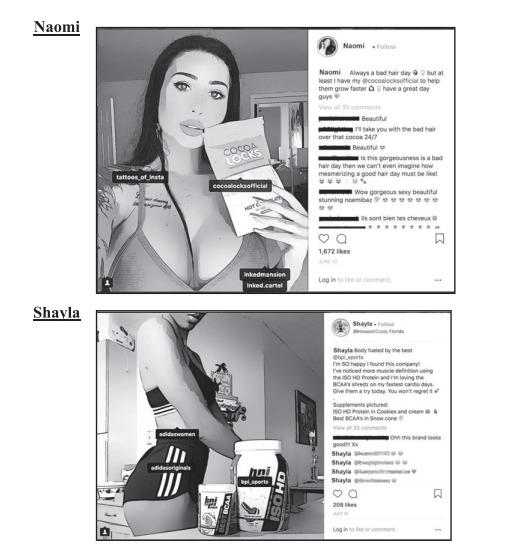
Engagers are similar to hopefuls, but brands pay them to look seductive and promote their products. They put a lot of work into looking gorgeous in their professionally produced photos. They receive many weird comments since they appear to be available at all times.

Boosters: They market their own products and utilize their sensuality to entice customers to buy them. They interact with followers as if they were friends and utilize methods like hashtags and giveaways to gain attention.

Performers: They are similar to boosters, but they go one step farther. They utilize sexual emojis and occasionally refer followers to other websites where they can chat for money. However, their pictures are occasionally exploited without permission for shady purposes.
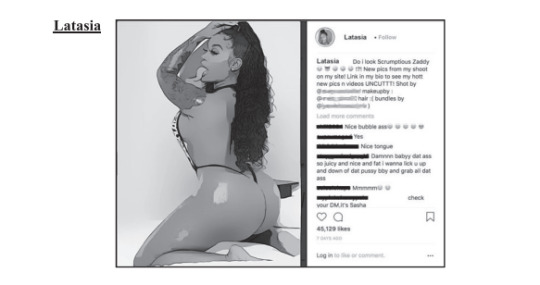
Reference list
Drenten, J, Gurrieri, L & Tyler, M 2019, ‘Sexualized labour in digital culture: Instagram influencers, porn chic and the monetization of attention’, Gender, Work & Organization, vol. 27, no. 1.
0 notes
Text
Week 6. Slow Fashion
"What you wear says something about you, right? Yeah, you wear that shirt it says you like that band. You wear those combat boots, it says you're edgy.
Fashion is a huge part of our culture. "
1. Setting the scene: The Glamour Facade
Fast fashion, like a fast-food version of high fashion, characterized by its cheap prices and rapid turnover of trendy clothing, has become a dominant force in the apparel industry (Nguyen 2023). However, the allure of fast fashion hides a darker reality of environmental harm, exploitation, and unsustainability.
One defining aspect of fast fashion is its affordability. Brands like Zara and H&M achieve this by mimicking designer styles at a fraction of the cost, making fashion trends accessible to the masses (Nguyen 2023).

While this democratization of fashion may seem positive, it comes at the expense of quality. Fast fashion garments are often made from low-quality fabrics that are difficult to recycle and end up in landfills or polluting waterways (Hanson 2019). Synthetic materials like polyester contribute significantly to environmental degradation, emitting large amounts of carbon during production and shedding microplastics when washed (Hanson 2019).
Moreover, the production processes involved in fast fashion are environmentally damaging. From the extraction of raw materials to textile dyeing, toxic chemicals are used and often disposed of improperly, polluting water sources (Drew & Yehounme 2017). Additionally, fast fashion relies on cheap labor, often in developing countries, where workers are subjected to poor working conditions and low wages (ABC News (Australia) 2023).


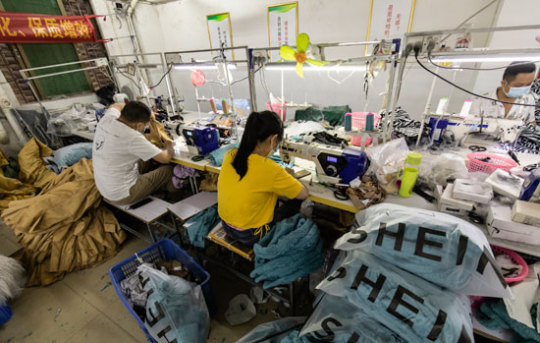
Economically, the fast fashion industry is booming, with the global apparel market valued at over 1.53 trillion U.S. dollars and predicted to reach nearly 2 trillion U.S. dollars by 2028 (Smith 2023b; Smith 2023a). However, this economic growth comes at a cost. The environmental impacts of fast fashion are severe, with the production of synthetic fabrics alone consuming vast amounts of oil and contributing to pollution, as seen in the case of the Citarum River in Indonesia, where factories associated with fast fashion brands have polluted the water, causing health issues such as chemical pollution for local children (Java Discover 2022).

Furthermore, the fast fashion industry's reliance on social media exacerbates its environmental and social impacts. Social media often glamorizes a lifestyle where clothes are worn once or twice for the perfect photo (Netflix Is A Joke 2020). This mentality fuels a "disposable wardrobe" attitude, leading to more clothes ending up in landfills. In addition, the constant stream of new trends promoted by influencers pushes people to buy on impulse without considering quality or long-term wear, contributing to the cycle of waste and exploitation (Netflix Is A Joke 2020).
2. The Rise of Slow Fashion
Amidst the challenges posed by fast fashion, the movement towards slow fashion is gaining popularity. Slow fashion emphasizes transparency, sustainability, and ethical practices, offering an alternative to the wasteful and exploitative nature of the fast fashion industry (Domingos, Vale & Faria 2022). The global secondhand clothing market was valued at $177 billion in 2022 and is expected to nearly double by 2027, reaching a staggering $351 billion (Smith 2023c).

As awareness of the environmental and social impacts of fashion grows, consumers are demanding more transparency and accountability from brands (Domingos, Vale & Faria 2022). They are seeking out companies that prioritize sustainability and ethical production methods (Domingos, Vale & Faria 2022). This shift in consumer behavior is prompting businesses to innovate and adopt greener practices to meet the expectations of their customers (Choi & Han 2019).
To qualify as sustainable, fashion labels are adopting four guiding principles:
(1) Child labor-free production
(2) Environmentally friendly materials
(3) Ethical production processes
(4) Long-term relationships across the supply chain
3. First Steps of A Conscious Journey
I'd prefer to call it "slower," knowing that many young people, like myself, occasionally purchase fast fashion items.
a. Evaluate & support slow fashion brands: Look for brands that use environmentally friendly materials and promote fair labor practices throughout their supply chain.
b. Explore thrifting and clothing swaps: Embrace thrifting as a fun and sustainable way to refresh your wardrobe. Visit thrift stores or participate in clothing swaps with friends to give new life to pre-loved garments. Platforms like Big Sister Swap is a prime example. The concept behind Big Sister Swap is simple yet powerful: it's a clothes-swapping platform that is size-inclusive, environmentally conscious, and chic. Users can participate by purchasing a Swap option based on their willingness to donate clothes and their preferences for receiving items in return (Nast 2022).

c. Get creative with DIY: Tap into your creativity by engaging in DIY projects or clothing modifications. Transform old garments into new, trendy pieces through sewing, painting, or embellishing techniques.
d. Utilize social media for inspiration: Social media platforms can serve as valuable resources for sustainable fashion inspiration. Follow influencers like Annika Victoria, an Australian Youtuber who shares insights and tutorials on sustainable fashion practices (YouTube n.d.). Her main claim to fame is her 'make thrift buy' series where she recreates weird internet fashion and does her best to sew it, giving full, in depth tutorials so people can have the mega trendy but done more sustainably and purposefully. (She is retired from YouTube now, but there are plenty of other younger influencers, such as bestdressed or Ally Purugganan. Find the style of thrift you love and let the algorithm shower you with content, hehe.)
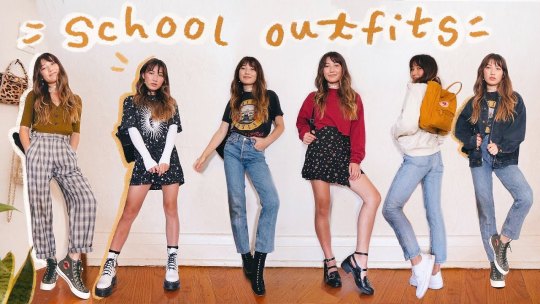

A crucial question remains: How can we support young people in embracing themselves and resisting the harmful influence of consumerism? It's evident they desire many things: they understand the negative effects of fast fashion, yet may not afford slow fashion or may not enjoy thrifting. They seek something that combines the sustainability of slow fashion with the trendiness and convenience of fast fashion.

The answer is clear: With every purchase we make a decision that impacts nature and society. If today we prioritize running after toxic trends, tomorrow we will suffer inside and out. Promoting
the idea that sustainable consumption leads to a very positive and effective image could be a potential solution for achieving an increase in sustainable fashion (Domingos, Vale & Faria 2022). However, if one cannot fully embrace slow fashion, at least reduce fast fashion consumption and engage in more eco-friendly activities and habits. Fashion is among the most environmentally harmful industries, so every effort counts.
Reference list
ABC News (Australia) 2023, ‘The dark side of Shein’s success | China Tonight | ABC News’, www.youtube.com, viewed <https://www.youtube.com/watch?v=eIuM6lykHxc>.
bestdressed 2020, ‘here are some things i thrifted in nyc :)’, www.youtube.com, viewed <https://www.youtube.com/watch?v=nihjDIczdCA&list=PLTfSzFnwTcWS7PvVG5FM0Uaz5CMLdnVH4>.
Choi, D & Han, T-I 2019, ‘Green Practices among Fashion Manufacturers: Relationship with Cultural Innovativeness and Perceived Benefits’, Social Sciences, vol. 8, no. 5, p. 138, viewed <https://www.mdpi.com/2076-0760/8/5/138>.
Domingos, M, Vale, VT & Faria, S 2022, ‘Slow Fashion Consumer Behavior: a Literature Review’, Sustainability, vol. 14, no. 5, p. 2860.
Drew, D & Yehounme, G 2017, ‘The Apparel Industry’s Environmental Impact in 6 Graphics’, World Resources Institute, World Resources Institute, viewed <https://www.wri.org/insights/apparel-industrys-environmental-impact-6-graphics>.
Hanson, M 2019, ‘Fashion Contributes to 10 Percent of Humanity’s Carbon Emissions’, Big Think, viewed <https://bigthink.com/the-present/is-fashion-bad-for-the-environment/>.
Java Discover 2022, ‘The Fashion Industry’s Dirty Secret: the World’s Most Polluted River in Indonesia | Documentary’, www.youtube.com, viewed <https://www.youtube.com/watch?v=ZHOuJXbZtsk>.
Nast, C 2022, ‘It’s time to get to know Big Sister Swap, AKA the personalised clothes swapping service that everyone is talking about’, Glamour UK, viewed <https://www.glamourmagazine.co.uk/article/big-sister-swap?utm_source=onsite-share&utm_medium=email&utm_campaign=onsite-share&utm_brand=glamour-uk>.
Netflix Is A Joke 2020, ‘The Ugly Truth Of Fast Fashion | Patriot Act with Hasan Minhaj | Netflix’, www.youtube.com, viewed <https://www.youtube.com/watch?v=xGF3ObOBbac&t=1430s>.
Nguyen, HN 2023, Fast Fashion & Greenwashing: the Worst Combination for Sustainability, ResearchGate, pp. 1–7, viewed <https://www.researchgate.net/publication/373632703_Fast_Fashion_Greenwashing_The_Worst_Combination_for_Sustainability>.
Smith, P 2023a, ‘Global Apparel Market - Statistics & Facts’, Statista, viewed <https://www.statista.com/topics/5091/apparel-market-worldwide/#topicOverview>.
Smith, P 2023b, ‘Revenue of the Global Apparel Market 2014-2027’, Statista, viewed <https://www.statista.com/forecasts/821415/value-of-the-global-apparel-market>.
Smith, P 2023c, ‘Secondhand Apparel Market Value Worldwide 2012-2023’, Statista, viewed <https://www.statista.com/statistics/826162/apparel-resale-market-value-worldwide/>.
YouTube n.d., ‘Annika Victoria - YouTube’, www.youtube.com, viewed 27 March 2024, <https://www.youtube.com/@AnnikaVictoria24>.
#swinburne#university#social media#slow fashion#fast fashion#sustainable#fashion influencer#youtube#enviromental#mda20009
0 notes
Text
Week 5. Digital Citizenship
The idea of citizenship has been extensively studied in education, communication, and political science. Within academia, there's a growing focus on digital citizenship, which has become an important part of many school systems' goals. Recent events like the Black Lives Matter (BLM) movement and the Covid-19 pandemic have underscored the significance of understanding digital citizenship, especially in how it impacts marginalized communities.
1. Definition: What is digital citizenship? (Council of Europe 2022)

Digital citizenship involves the skills needed to actively and responsibly engage online and offline, from local to global communities. It emphasizes the ability to adapt to changing digital technologies from childhood onward. Digital citizens participate in various online activities such as creating, sharing, learning, and working, while also respecting the rights and differences of others. These skills shape how individuals behave and interact in the online world, encompassing principles, attitudes, abilities, and knowledge necessary to navigate the digital landscape responsibly. They enable individuals to influence technology according to their needs rather than being solely influenced by it.
2. Approaches to Digital Citizenship (Choi & Cristol 2021)
There are three main approaches to digital citizenship.
(1) Unidimensional Approach: This approach focuses on specific aspects of digital citizenship within different disciplines such as education, communication, journalism, and political science.
(2) Multidimensional Approach: This approach emphasizes various dimensions of digital citizenship.
It categorizes digital citizenship into four main areas: digital ethics, media and information literacy, participation/engagement, and critical resistance.
Additionally, it proposes a digital citizenship scale model based on five levels of complexity: technical skills, local/global awareness, networking agency, critical perspective, and Internet political activism.

However, while the multidimensional approach is comprehensive, it lacks a focus on critical aspects of digital citizenship.
Therefore, there's a need for a more critical and radical approach to digital citizenship education. This approach should acknowledge and address unequal power dynamics and social injustices presented on the Internet as well as social media platforms.
A critical and radical approach to digital citizenship aims to make visible the social relations embedded in technology and advocates for emancipatory technological practices to promote social justice.
This sets the stage for introducing a framework in the next section.
3. Using An Intersectionality Framework for Digital Citizenship Education (Choi & Cristol 2021)
Intersectionality is a framework that recognizes how multiple aspects of identity intersect and interact across social determinants, contributing to complex inequalities.
This framework has been applied across various disciplines and topics to understand social and health inequities.
In the field of education, intersectionality has been used to analyze differences in educational experiences based on the intersection of gender and race within different age groups.
Intersectionality offers valuable insights for gaining a deeper understanding of digital citizenship and participatory democracy, particularly in relation to how social identities intersect with online activities and experiences.

4. Participatory Democracy and Digital Citizenship (Choi & Cristol 2021)
To begin with, the main aim of digital citizenship education is to promote participatory democracy, focusing on diversity, inclusion, equity, and social justice. Achieving participatory democracy involves everyday actions like expressing opinions and engaging in personalized politics. This can include discussing politics with friends, talking to public officials, working on political campaigns, or persuading others to vote for or against a candidate.
Nevertheless, participatory democracy extends beyond politics to include communication, engagement, and personal development in various aspects of life. Teaching digital citizenship should encompass different forms of participation, not just political involvement. By integrating digital citizenship education, participatory democracy can empower younger generations who are familiar with expressing themselves online across diverse areas. This can also amplify the voices of underprivileged students, making them more visible and heard.
5. Social Media, Hashtag Publics and Activism (Choi & Cristol 2021)
Social media is often used in schools to encourage civic engagement and political involvement among students. Teachers should understand the influence of social media in the public sphere and tailor it to meet students' individual needs. Social media allows marginalized groups to express their views publicly, as shown in Gleason and Von Gillern's study where participants supported Senator Wendy Davis in the #StandWithWendy movement to defend reproductive rights.
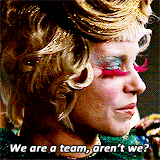
Teachers working with marginalized and/or under-represented students using technology or social media should recognize the biases present in current educational systems, which can perpetuate social inequalities. They should incorporate digital literacy into their teaching methods to accommodate diverse learners, thus enhancing learning outcomes and empowering students with various identities to express themselves.
In a study conducted at Thai Nguyen University in Vietnam, educators and students devised innovative strategies to enhance digital citizenship education. (Hoang et al. 2020)
While the teachers’ plans focused on improving students' digital etiquette in social media groups, students' action plans were more practical and specific, suitable for students' everyday life and academic study.
Teaching Action Plans
• Target disadvantaged students with limited digital access to online homework.
• Plans included:
(1) Assigning students in groups with device sharing
(2) Proposing extended library and computer lab hours
(3) Focusing on teaching teachers about important aspects of technology issues through workshops. (They understood how crucial this knowledge is for educators who regularly work with students online. This would help teachers better prepare students with the skills and knowledge for responsible technology use.)
Student Action Plans
• Plans included:
(1) Designing an application for time management and digital health
(2) Integrating digital citizenship into teaching internship programs
(3) Creating a YouTube-related video for parents to explain the dangers of letting children watch YouTube videos.
Overall, 70% of action plans received the highest score range for their good understanding of digital citizenship and applying the concept to real-life problems.
Last but not least, the article includes recommendations for institutions, such as creating open discussions, integrating digital citizenship content in syllabi, and providing accessible resources for students and parents.
In conclusion...
...understanding digital citizenship through an intersectional lens is crucial for fostering participatory democracy through digital citizenship education. Teachers should emphasize the intersectionality of race, gender, class, and language when addressing digital citizenship and related topics. This approach influences how educators, administrators, and policymakers perceive and support students' academic success and challenges in school.
Reference list
Choi, M & Cristol, D 2021, ‘Digital Citizenship with Intersectionality Lens: Towards Participatory Democracy Driven Digital Citizenship Education’, Theory Into Practice, vol. 60, no. 4.
Council of Europe 2022, 2022 Edition of the Digital Citizenship Education Handbook, Digital Citizenship Education (DCE).
Hoang, DTN, Tran, TTT, Nguyen, NTB & Nguyen, LT 2020, ‘Digital Citizenship Awareness in EFL Context in Vietnam : a Project Evaluation’, The Journal of AsiaTEFL, vol. 17, no. 1, pp. 225–233, viewed 16 December 2020, <https://www.researchgate.net/publication/340331318_Digital_Citizenship_Awareness_in_EFL_Context_in_Vietnam_A_Project_Evaluation>.
#mda20009#swinburne#digital citizenship#education#digital literacy#university#social media#politics#hashtag#activism
0 notes
Text
Week 4. Reality TV in the Age of Social Media
The given article explores the fascinating interaction between reality TV and social media, highlighting both its benefits and drawbacks. It goes beyond simply describing the impact and the power dynamics, as well as evolving concept of "authenticity" of reality TV in this digital age.
1. Features of Reality TV in the Social Media Era
Gone are the days of passive viewing. Social media has transformed reality TV consumption into an interactive experience. Online discussions are filled with witty commentary, memes, and GIFs, giving iconic moments a life beyond the show itself. The rise of streaming services further expands access, allowing new audiences to discover past gems.
2. Benefits for Participants
Social media empowers participants to reclaim their narrative. They can offer their perspective on editing choices, challenging the constructed "reality" and sparking discussions about authenticity. Furthermore, platforms like Instagram and YouTube offer avenues for income generation and brand promotion, extending their 15-minutes of fame. After the 2020 Netflix reality show "Too Hot To Handle," Francesca Farago emerged as one of the most famous figures. Her Instagram following skyrocketed from 300K to 3M post-show, enabling her to generate substantial income through the platform, alongside sponsorships, modeling contracts, digital ad campaigns, and guest appearances (Nathani 2020). In addition, she introduced her swimwear line, "Farago the Label," and established a website offering merchandise like t-shirts and hoodies (Marie Claire 2020).

3. Drawbacks and Ethical Concerns
The flip side of accessibility is exposure to negativity. Participants face the harsh reality of online trolls and potentially harmful comments. This raises ethical concerns about the psychological impact of reality TV participation in the social media age.
4. Reality TV's Influence
Beyond mere entertainment, reality TV has demonstrably influenced online self-presentation formats like vlogs and social media stories. These formats echo the video diary style, but with a more casual and unfiltered approach. Reality TV's "amateur" aesthetic, achieved through leaving in mistakes and eschewing traditional broadcasting conventions, is adopted by YouTubers seeking to appear relatable and intimate with their audience.
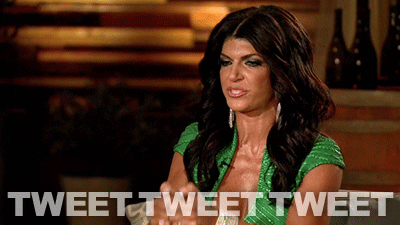
5. Comparing Reality and Traditional Celebrities
The concept of "authenticity" takes center stage in both reality TV and social media. Reality stars and internet personalities, categorized as "microcelebrities," leverage this perceived authenticity to cultivate their fanbases. They achieve this through "calibrated amateurism," which involves addressing the audience directly, sharing glimpses of their personal lives, and even leaving editing errors. For traditional celebrities, social media offers a platform to bypass intermediaries and connect directly with fans, showcasing a curated yet seemingly "authentic" side of themselves.

6. The Future of Reality TV
This genre's future seems intertwined with technological advancements. Expect to see reality TV capitalizing on virtual and augmented reality, further blurring the lines between real and constructed. Streaming services and hybrid formats that combine elements of celebrity, distribution, and content consumption are also likely to become more prevalent. While ethical concerns remain, the article predicts a focus on scapegoating individuals rather than addressing systemic issues of exploitation. Despite its complexities, reality TV shows no signs of disappearing, solidifying its place as a cornerstone of the television landscape.
Reference list
Deller, RA 2020, Reality television : the television phenomenon that changed the world, Emerald Publishing, Bingley, England, pp. 153–175.
Marie Claire 2020, Francesca Farago From ‘Too Hot to Handle’ Is a Reality Star to Watch, Marie Claire Magazine, viewed 11 February 2024, <https://www.marieclaire.com/celebrity/a32175404/francesca-farago-too-hot-to-handle/>.
Nathani, N 2020, Too Hot to Handle’s Francesca Farago Set to Make Nearly $1 Million from Instagram Posts in 2020, ScreenRant, viewed 11 February 2024, <https://screenrant.com/too-hot-to-handle-francesca-farago-instagram-followers/#:~:text=When%20Screen%20Rant%20spoke%20with%20Francesca%20on%20the>.
1 note
·
View note
Text
Week 3. Tumblr as a digital community
Part 1. About Tumblr
1. What is Tumblr
- Overview: Tumblr is a New York-based internet platform launched in 2007, blending features of a microblog and a social network. (Dixon 2024)
- Acquisition and Popularity: Acquired by Yahoo! Inc. in 2013 for $1.1 billion. However, its user base declined after a controversial ban on adult content in 2018. (Dixon 2024)
- User Demographics: Popular among young Millennials. In the USA, app users spend nearly 118 monthly minutes on average (Dixon 2024). In Australia, it ranks as the 10th most popular social media platform, with 3.7 million Unique Australian Visitors (Correll 2024). However, it's not as popular in Vietnam due to its niche status (Oosga 2023).
2. Why Tumblr was started

- Purpose: Tumblr was created to bridge the gap between long-form blogging and status updates on platforms like Twitter and Facebook (Schonfeld 2011).
- Ease of Use: Founder David Karp believed existing blogging platforms were too complicated, leading him to create Tumblr for quick and easy posting of thoughts and images (Schonfeld 2011).
- Expressive Identity: Tumblr was designed to offer a space for creative expression and customization, unlike Facebook and Twitter, which lack a strong identity-focused approach (Schonfeld 2011).
3. Functions of Tumblr
- Blogging Features: Users can create diaries, post inspiring content, and liveblog about events or TV shows (Tumblr n.d.).
- Post Types: Supports various post formats including text, photos, quotes, links, chats, audio, and video (Tumblr n.d.).
- Social Interaction: Users can like and reblog posts, and communicate with other accounts. Privacy settings are available for those who prefer to keep their content private (Tumblr n.d.).
Part 2. The Public Sphere
(from additional reading article “Social Media as a Public Sphere? Politics on Social Media”)
1. Introduction

The concept of the public sphere, as introduced by German sociologist and philosopher Jürgen Habermas, refers to a space in society where individuals come together to engage in rational discourse and debate about matters of common concern.
This article discusses social media's potential to engage people in communicative action to realize a public sphere and participatory democracy.
2. Opinions of the participants and the “hug box” mentality
According to the research, social media is not as effective at promoting the kind of respectful public sphere that Habermas illustrated. Only a small number of the 29 participants (3.4%) engaged in uncivil political debate, while the majority (72.4%) perceived a lack of civil discussion. Participants, especially millennials who feared interpersonal disputes and engaged in self-censorship, indicated concerns about potential conflicts that could arise from sharing thoughts online.

The perceived anonymity and detached nature of online contacts, which made it more possible for certain people to act abusively without consequence, making the stakeholders more fearful of participating online. While some participants aired their controversial opinions anonymously to prevent harassment, many participants completely avoided discussions on politics. Users are likely to unfriend or hide posts and comments from others who hold opposing views, which can restrict their exposure to a range of beliefs and worsen division.
Given that social media is a platform for entertainment and interpersonal connections, most participants thought it should stay away from sensitive subjects and negativity. The "hug box" concept explains how users interact primarily with people who match their opinions, which polarizes politics.
In summary, the study draws attention to the difficulties that social media presents in facilitating constructive discussion.
Digital media and fragmentation:
Critics contend that the fragmentation of public sphere is a result of the growth of digital media and internet platforms. There are now numerous divided public spheres based on personal interests, ideologies, and identities in place of a single, cohesive one. Meaningful discussion and deliberation can be restricted by echo chambers and filter bubbles, where people are only exposed to content and perspective that confirm their preexisting opinions.
Social media surveillance techniques restrict participation and information because users are frequently seen by friends, family, employers, law enforcement, and other public bodies. Users' ability to use social media for meaningful idea exchange is restricted by this monitoring, which may make them reluctant to be open about their political views. Algorithms that limit information are also made possible by surveillance; an example of this is the Facebook algorithm that anticipates user preferences based on how they behave online.
2. The commercialization and corporatization of the media have intensified since Habermas's time.
The corporations behind social media, driven by capitalist market forces, produce algorithms that contribute to the hug box mentality. This isolation prevents meaningful dialogue and creates political polarization. When participants do post or comment about politics on social media, they do so within limited parameters, either anonymously or with others they know would agree with them. Those with differing views are unfollowed or unfriended. Therefore, the "hug box" is driven by corporate algorithms, defriending, and fears about interpersonal conflict, shutting down opportunities for discourse on social media.
3. Social inequality and exclusion
The public sphere aims to include everyone, but it often leaves out voices from marginalized groups. This exclusion happens in various ways, like women and minorities feeling socially excluded, barriers stopping people from getting information and joining in, and not everyone having internet access. This exclusion goes against the democratic values of fairness and participation that Habermas talks about. Also, some research looks into how people fear being watched at work and losing their jobs because of what they say on social media. Many in Generation X, for example, avoid talking about politics online because they worry about getting in trouble with their managers. They think that employers and big companies have too much power on social media.
Part 3. Tumblr as a digital community for young feminists
(from the additional reading article “Oh, She’s a Tumblr Feminist”: Exploring the Platform Vernacular of Girls’ Social Media Feminisms)
1. How do different platform vernaculars work to offer opportunities for feminist activism?
The article also explores how the platform vernaculars of Twitter, Facebook, and Tumblr. Facebook is useful for engaging in peer education around feminist issues, while Twitter is not suitable for cultivating collective responses to sexism. Tumblr offers a distinctive social privacy to feminist girls, providing a sense of cover from both family and friends and anonymous trolls. However, girls' social media practices remain limited by how gendered power relations operate online, most notably in the form of sexist harassment.
2. Why Tumblr is a safe space for the young feminists?

The platform differs from other social media in several ways, including the absence of personal profiles or networks of "friends," making many "Tumblrs" anonymously created and owners difficult to identify. Tumblr users favor communication through images and function more as content curators through posting both original and "reblogged" content. This anonymity is an important reason why many teenage feminists choose to use the platform. In a focus group conversation, London-based girls agreed that Tumblr was the easiest digital space to practice feminism as a young person. The platform's affordances, such as its de-prioritizing of searchability in the site's design, grant users a sense of freedom from the constraints of more traditional networked social media, like being in a "black hole."
3. Are teenage girls aware of the pros and cons when they do feminist activism online via specific platforms?
Teenage girls are savvy social media users, demonstrating keen knowledge about the platforms they regularly use and how they work. They make conscious decisions about what to post and where, weighing issues like public visibility, peer support, anonymity, and social privacy before they upload content. This finding suggests that girls are not naive about the workings of the social media they use and actively use this knowledge when doing feminism online.
Reference list
Correll, D 2024, Social Media Statistics Australia – January 2024 : Social Media News Blog Australia, www.socialmedianews.com.au, viewed 11 February 2024, <https://www.socialmedianews.com.au/social-media-statistics-australia-january-2024/>.
Dixon, SJ 2024, Tumblr - Statistics & Facts, Statista, viewed 11 February 2024, <https://www.statista.com/topics/2463/tumblr/#topicOverview>.
Keller, J 2019, ‘“Oh, She’s a Tumblr Feminist”: Exploring the Platform Vernacular of Girls’ Social Media Feminisms’, Social Media + Society, vol. 5, no. 3, pp. 1–11.
Kruse, LM, Norris, DR & Flinchum, JR 2018, ‘Social Media as a Public Sphere? Politics on Social Media’, The Sociological Quarterly, vol. 59, no. 1, pp. 62–84.
Oosga 2023, Social Media in Vietnam - 2023 Stats & Platform Trends - OOSGA, oosga.com, viewed 11 February 2024, <https://oosga.com/social-media/vnm/>.
Schonfeld, E 2011, (Founder Stories) Why David Karp Started Tumblr: Blogs Don’t Work For Most People, TechCrunch, viewed 11 February 2024, <https://techcrunch.com/2011/02/21/founder-stories-why-david-karp-started-tumblr-blogs-dont-work-for-most-people/>.
Tumblr n.d., Posting, Tumblr Inc., viewed 11 February 2024, <https://help.tumblr.com/hc/en-us/categories/203334767-Posting>.
1 note
·
View note